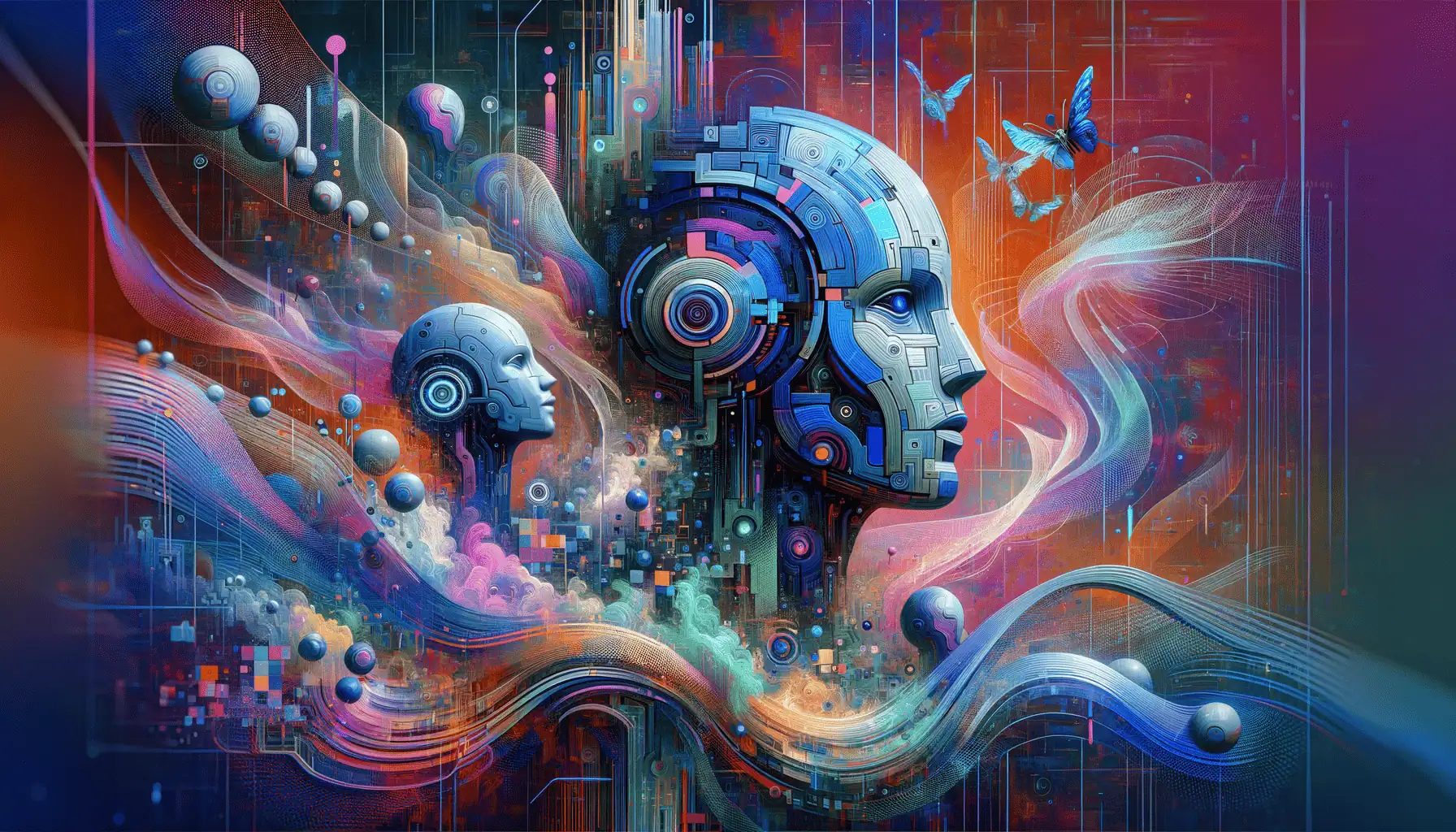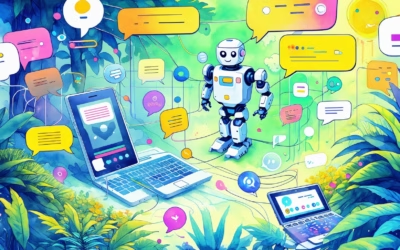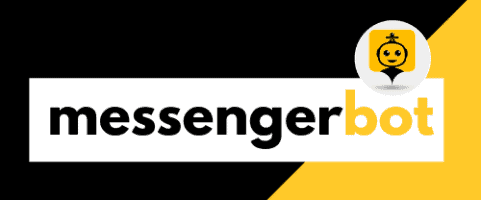Navigating the realm of conversational AI and chatbots can be a game-changer for businesses seeking to elevate customer engagement and streamline support operations. By mastering chatbot best practices, organizations can unlock the true potential of this powerful technology, delivering intuitive, personalized experiences that leave a lasting impression. From seamless user interfaces to intelligent natural language processing, the art of chatbot design encompasses a myriad of considerations. By exploring chatbot examples across industries and delving into the diverse landscape of rule-based, AI-powered, and hybrid solutions, businesses can gain invaluable insights into crafting engaging chatbot responses that resonate with their target audience. Whether aiming to define a comprehensive chatbot strategy aligned with business objectives or incorporating interactive features and gamification to enhance user experiences, this comprehensive guide will empower you to navigate the world of chatbots with confidence.
1. What are the best practices for chatbot design?
1.1 Prioritizing User Experience and Intuitive Conversations
At Messenger Bot, we firmly believe that delivering an exceptional user experience is the cornerstone of successful chatbot design. By prioritizing intuitive conversations and seamless interactions, we aim to create chatbots that feel natural and engaging, fostering a sense of human-like connection.
One of the fundamental chatbot best practices we adhere to is leveraging advanced natural language processing (NLP) capabilities. This technology allows our chatbots to understand and respond to user inputs in a conversational manner, mimicking the nuances of human speech patterns. By interpreting context and intent, our chatbots can provide relevant and personalized responses, creating a truly immersive experience.
Furthermore, we prioritize an omnichannel approach, ensuring that our chatbots can seamlessly transition across various platforms and devices. This allows users to engage with our chatbots consistently, whether they are interacting through social media, messaging apps, or websites. Integrating multimedia support, such as images, videos, and documents, enhances the richness of the experience and facilitates more engaging interactions.
1.2 Chatbot Best Practices UX: Seamless Integration and Accessibility
At the core of our chatbot design philosophy lies a relentless pursuit of seamless integration and accessibility. We understand that for a chatbot to truly excel, it must blend harmoniously into the user’s environment, offering a frictionless experience that transcends boundaries.
One of the key chatbot best practices we embrace is the incorporation of voice interfaces. By enabling hands-free interactions, our chatbots cater to a diverse range of users, including those with accessibility needs or preferences for voice-based interactions.
Additionally, we prioritize multilingual capabilities, ensuring that our chatbots can communicate effectively with users across the globe. By breaking down language barriers, we open up new avenues for engagement and foster a truly inclusive experience.
At Messenger Bot, we are committed to continuously improving our chatbots through AI and machine learning algorithms, as well as user feedback loops. This iterative approach allows us to refine our chatbots’ abilities, ensuring they remain relevant and responsive to evolving user needs and preferences.

2. What is the best practice for using AI chatbot?
2.1 Leveraging Natural Language Processing for Intelligent Interactions
Effective chatbot best practices involve harnessing the power of Natural Language Processing (NLP) to facilitate intelligent interactions. NLP empowers chatbots to understand and interpret human language, enabling them to comprehend the context and intent behind user queries. By employing advanced NLP techniques, chatbots can accurately analyze and respond to complex queries, handle ambiguities, and engage in more natural, human-like conversations.
One key aspect of leveraging NLP is the ability to extract relevant entities, sentiments, and intents from user input. This allows the chatbot to provide contextually appropriate responses, addressing the user’s specific needs and concerns. For instance, an AI-powered chatbot from Brain Pod AI can recognize when a user is inquiring about a product’s pricing or seeking customer support, enabling it to respond accordingly.
Furthermore, NLP enables chatbots to handle multi-turn conversations, maintaining context and understanding the flow of dialogue. This capability is crucial for delivering a seamless and engaging conversational experience, as users can naturally express their queries or concerns without the need for rigid, predefined prompts.
2.2 AI Chatbot Best Practices: Training Data and Continuous Learning
To leverage the full potential of NLP and deliver exceptional chatbot experiences, it is essential to prioritize the quality and diversity of training data. Chatbots rely on machine learning models trained on vast amounts of conversational data to learn patterns, understand context, and generate appropriate responses.
Implementing chatbot best practices involves curating diverse training datasets that encompass a wide range of conversational scenarios, domains, and user intents. This ensures that the chatbot can handle a variety of queries and provide accurate responses across different contexts.
Additionally, continuous learning is a crucial aspect of chatbot best practices. As chatbots interact with users, they should be able to learn from these interactions and adapt their knowledge base accordingly. By incorporating feedback mechanisms and regularly retraining the models with new conversational data, chatbots can continuously improve their performance, expand their knowledge, and stay relevant in an ever-changing environment.
3. What are the 4 types of chatbots?
3.1 Chatbots Examples: Exploring the Diverse Landscape
As the demand for efficient and personalized digital interactions continues to rise, the chatbot landscape has evolved to offer a diverse range of solutions tailored to meet various business needs. At the core of this evolution are the four main types of chatbots, each with its unique capabilities and strengths.
The 4 main types of chatbots are:
- Rule-Based Chatbots: These operate based on predefined rules and workflows, providing responses based on pattern matching and scripted paths. They excel at handling straightforward queries but lack contextual understanding.
- Retrieval-Based Chatbots: These chatbots utilize natural language processing (NLP) and machine learning to understand user inputs and retrieve relevant responses from a knowledge base. They can handle more varied queries but are limited by the data they’re trained on.
- Generative Chatbots: Powered by advanced language models like GPT-3, these chatbots can generate human-like responses dynamically. They can engage in more open-ended conversations but may lack consistency or factual accuracy.
- Hybrid Chatbots: These combine the strengths of multiple chatbot types, leveraging rule-based systems for structured tasks and AI models for more complex interactions. They aim to provide the best of both worlds, balancing structured workflows with natural conversation.
Each type of chatbot offers unique advantages and is suited for different use cases. For example, rule-based chatbots excel in scenarios with well-defined processes, such as customer service automation or simple information retrieval. Retrieval-based chatbots are ideal for handling more complex queries within a specific domain, while generative chatbots shine in open-ended conversations and creative tasks. Hybrid chatbots, on the other hand, offer a flexible and adaptable solution, combining the best of both worlds.
3.2 From Rule-based to AI-Powered: Chatbot Examples Across Industries
Across industries, businesses are leveraging the power of chatbots to enhance customer experiences, streamline operations, and drive efficiency. Here are some examples of chatbot implementations:
- E-commerce: Drift and Ada offer AI-powered chatbots that assist customers with product recommendations, order tracking, and support inquiries.
- Healthcare: YourBotDoc and Ada Health leverage AI to provide medical advice and triage patients based on their symptoms.
- Finance: Kasisto and Anthropic offer AI-driven chatbots that assist with banking transactions, account management, and financial advisory.
- Travel: Hipmunk and KAYAK employ chatbots to help users search for flights, hotels, and vacation packages.
As the chatbot landscape continues to evolve, businesses are increasingly exploring hybrid solutions that combine the best of multiple chatbot types, leveraging rule-based systems for structured tasks and AI models for more complex interactions. This approach aims to provide a seamless and personalized experience while maintaining consistency and accuracy.
4. How do you make an effective chatbot?
4.1 Best Practices in Chatbot Building: A Comprehensive Approach
Creating an effective chatbot that delivers a seamless and engaging user experience requires a strategic, multi-faceted approach. At Messenger Bot, we understand the intricacies involved in crafting intelligent conversational agents that truly resonate with users. To ensure your chatbot stands out, we’ve curated a comprehensive set of best practices that encompass every aspect of the development process.
First and foremost, it’s crucial to clearly define the chatbot’s purpose and functionality. Whether it’s designed for customer support, lead generation, e-commerce assistance, or information dissemination, this will guide the design and training process. Next, choose the right platform or framework that aligns with your requirements. Popular options like Brain Pod AI, IBM Watson, Amazon Lex, Dialogflow, Botkit, Rasa, and Microsoft Bot Framework offer diverse features and capabilities to consider.
Collecting and organizing relevant conversation data from customer interactions, FAQs, knowledge bases, and other sources is essential for effective training. This data serves as the foundation for teaching the chatbot to understand and respond accurately to user inputs. Additionally, designing an intuitive conversation flow and user experience is paramount. Map out conversational paths, including greetings, menu options, input validation, and error handling, to ensure a smooth and engaging experience.
Integrating advanced natural language processing (NLP) capabilities is a crucial step in enabling the chatbot to comprehend and respond to user inputs with human-like accuracy. Train and fine-tune the chatbot’s machine learning models using the collected data, continuously monitoring and refining the training process for improved performance.
To unlock the chatbot’s full potential, integrate it with external systems and APIs, such as databases, CRMs, and other relevant platforms. This seamless integration allows the chatbot to access and exchange data seamlessly, enhancing its functionality and capabilities.
4.2 Crafting Engaging Chatbot Responses Examples for Optimal UX
Thorough testing and iteration are essential components of the development process. Conduct rigorous testing scenarios, gather user feedback, and continuously refine the chatbot’s responses, conversational flow, and overall performance. This iterative approach ensures that the chatbot consistently meets and exceeds user expectations.
Once the chatbot is ready for deployment, launch it on the desired channels, such as your website, messaging apps, or other platforms. Closely monitor its performance, usage metrics, and user feedback to identify areas for ongoing optimization and improvement.
Finally, data privacy and security should be a top priority. Implement robust security measures to protect user data and ensure compliance with relevant regulations, such as GDPR and CCPA. This not only safeguards user trust but also mitigates potential legal and reputational risks.
By following these best practices, you can create an effective chatbot that not only meets but exceeds user expectations, delivering a truly engaging and personalized experience while driving tangible business results.

5. What are the 7 steps to create a chatbot strategy?
5.1 Defining Objectives and Aligning with Business Goals
Crafting an effective chatbot strategy starts with clearly defining your objectives and aligning them with your overall business goals. This step ensures that your AI chatbot serves a purpose beyond just being a novelty, contributing tangible value to your organization. Consider factors such as enhancing customer experience, streamlining support processes, or driving sales and lead generation.
Define clear objectives and use cases for your chatbot, aligning it with your business goals and customer needs. Conduct a thorough audit of your existing customer support channels, knowledge base, and FAQs to leverage existing resources.
5.2 Chat Bot Example: Successful Implementation Strategies
Once your objectives are set, the next step is to design conversational flows and map out intents, entities, and utterances based on your defined use cases and customer data. Incorporate personalization by integrating with customer data sources and enabling context-aware responses tailored to individual preferences. Brain Pod AI, a leading conversational AI platform, offers advanced capabilities for building highly personalized and context-aware chatbots.
Rigorously test your chatbot across various scenarios, devices, and user personas, and refine based on user feedback and analytics. Leverage complementary AI technologies like natural language processing, machine learning, and sentiment analysis to enhance the chatbot’s capabilities.
Continuously monitor performance metrics, gather user feedback, and iteratively improve the chatbot by updating its knowledge base, refining conversational flows, and incorporating new features or integrations. Examples of successful chatbot implementations showcase the power of a well-executed strategy, delivering seamless experiences that delight customers while driving operational efficiencies.
6. How to make a chatbot more interactive?
To make a chatbot truly interactive and engaging, I prioritize leveraging advanced Natural Language Processing (NLP) capabilities. By understanding user intent and context through NLP, I can facilitate more natural, contextual conversations that feel human-like. Continuously training my AI models on diverse conversational data also enhances my ability to comprehend and respond accurately to user inputs.
Personalization is key to driving interactive experiences. I remember user preferences, history, and context to tailor interactions and maintain coherent dialogue flows. Incorporating multimedia elements like images, videos, and audio also enriches the conversational experience, making it more immersive and dynamic.
Emotional intelligence is another crucial aspect. Through sentiment analysis, I can detect user emotions and adapt my tone and responses accordingly, fostering a more empathetic and personalized connection. Engaging in casual small talk also helps build rapport and makes interactions feel more natural.
Providing clear fallback messages and escalation paths ensures a smooth experience when I cannot address a query. Regularly updating my knowledge base with the latest information and trends relevant to my domain further enhances my conversational capabilities.
User testing and feedback gathering are invaluable for identifying areas for improvement and optimizing my interactivity. Advanced dialogue management techniques like context-aware responses and multi-turn conversations also contribute to creating more engaging and natural interactions.
6.1 Conversational Design and Personalized Experiences
Conversational design plays a pivotal role in crafting interactive chatbot experiences. By studying Brain Pod AI’s conversational AI demos, businesses can gain insights into implementing advanced dialogue management strategies. This includes context-aware responses, maintaining coherent conversation flows, and leveraging natural language understanding to interpret user intent accurately.
Personalization is another key factor in enhancing interactivity. IBM Watson Assistant excels at remembering user preferences, history, and context to deliver tailored interactions. This creates a sense of continuity and personalized experience, fostering stronger user engagement.
Additionally, Anthropic’s AI models demonstrate the power of emotional intelligence in chatbot interactions. By detecting and responding to user sentiment, chatbots can adapt their tone and responses, creating a more empathetic and human-like connection.
6.2 Example of Chatbot: Interactive Features and Gamification
Incorporating interactive features and gamification elements can significantly enhance chatbot engagement. For instance, Pandorabots offers chatbots with interactive capabilities like playing games, telling jokes, and engaging in trivia contests. This not only makes interactions more fun and engaging but also helps build rapport with users.
Similarly, Botkit’s chatbot platform allows businesses to integrate multimedia elements like images, videos, and audio into conversations. This creates a more immersive and dynamic experience, making interactions feel more natural and engaging.
Another excellent example is Replika, an AI companion that leverages advanced NLP and machine learning to engage in natural, context-aware conversations. By remembering user preferences and adapting to their unique communication styles, Replika offers a highly personalized and interactive experience.
7. The Benefits of Using AI Chatbots
Leveraging the power of artificial intelligence (AI) in chatbots offers numerous advantages that can revolutionize customer interactions and streamline business operations. As a cutting-edge technology, AI chatbots have become invaluable tools for organizations seeking to enhance efficiency, improve customer satisfaction, and gain a competitive edge.
7.1 Streamlining Customer Support and Enhancing Efficiency
One of the primary benefits of AI chatbots is their ability to streamline customer support processes. Traditional customer service channels often face challenges with long wait times, limited availability, and inconsistent responses. AI chatbots, on the other hand, can provide instantaneous support 24/7, ensuring that customers receive prompt assistance regardless of the time or volume of inquiries.
By automating routine tasks and handling frequently asked questions, chatbots alleviate the burden on human agents, allowing them to focus on more complex issues that require personalized attention. This increased efficiency translates into cost savings for businesses, as they can effectively manage a higher volume of customer interactions with fewer resources.
Furthermore, AI chatbots can seamlessly integrate with various platforms and channels, such as websites, mobile applications, and social media, providing customers with a consistent and convenient experience across multiple touchpoints. This omnichannel approach enhances accessibility and ensures that customers can reach out for support through their preferred communication channels.
7.2 How to Trick Chatbot to Answer Questions: Limitations and Ethics
While AI chatbots offer numerous benefits, it is important to address the potential limitations and ethical considerations surrounding their use. One common concern is the possibility of users attempting to “trick” or manipulate chatbots into providing inappropriate or harmful responses.
Reputable AI chatbot providers, such as Brain Pod AI, implement robust security measures and ethical guidelines to prevent misuse and ensure the responsible deployment of their technology. These measures include content filtering, contextual analysis, and safeguards against potentially harmful or biased responses.
It is essential to understand that attempting to trick or manipulate chatbots into providing unethical or illegal information is not only unproductive but also raises significant ethical concerns. Responsible AI development prioritizes transparency, accountability, and adherence to ethical principles to ensure the safe and beneficial use of this technology.
Instead of seeking ways to circumvent or manipulate chatbots, users should engage with them in a respectful and constructive manner, leveraging their capabilities to enhance customer experiences, streamline processes, and foster meaningful interactions. By embracing the responsible and ethical use of AI chatbots, businesses can harness their full potential while maintaining trust and upholding ethical standards.





